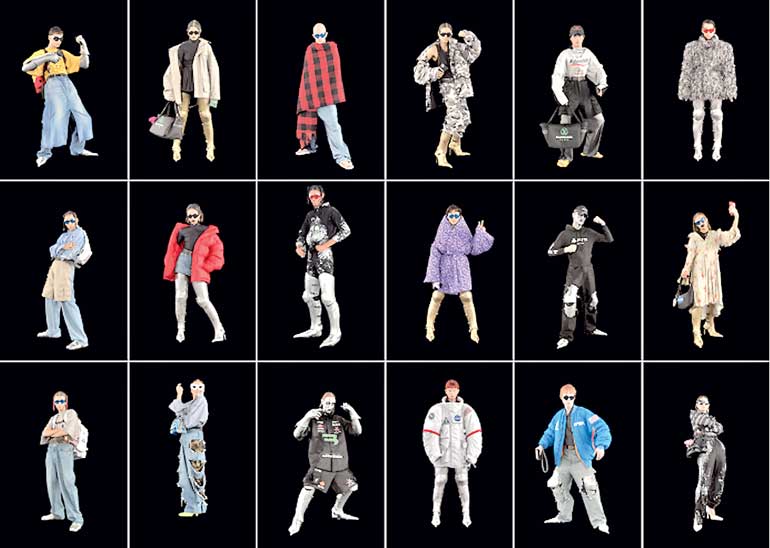Thursday Dec 18, 2025
Thursday Dec 18, 2025
Tuesday, 7 December 2021 00:02 - - {{hitsCtrl.values.hits}}

Balenciaga’s virtual fashion show
|
Gucci digital-only trainers that people can purchase and ‘wear’ using augmented reality |
 |
Metaverse and Web 3.0 have been in the news lately for many reasons, right and wrong. Some have called it a coverup for the mistakes made in Web 2.0 and others have called it another cog in the dystopian future we are heading towards. The adman in me has a wild imagination and the dataman in me pulls the imagination into a semi reality state. Whilst I read through Mathew Ball’s 33,000 word eight part primer on the #metaverse and listen to Mark Zuckerburgs initial chat with the man and then subsequently Mark and Garry V’s chats, it feels that we are on the cusp of something being created.
But when I go home and sit down with my 10-year-old daughter and her friend who are creating their new flight experience on #Roblox, or when I speak to my friend who just turned 60 and is hooked onto his #Peloton and loves to ride with other cyclists in the south of Spain or speak to some of my junior marketers at Enfection building a gamified platform for education marketing for an Australian client; it feels like this is more of a reality than we think.
The ecosystem around the #metaverse is still at its infancy, yet most of the platforms we use currently maybe obsolete even as we speak. The mobile phone as you know it, needs to change the way it looks and feels. AR/VR and holograms need to be true enablers with ‘meta supported’ #haptics. This 3D version of the internet is ready for player one but not for multiple players as of yet (see what I did there!).
So here’s what the dataman in me found out. As of today, there are 135,000 monthly #googlesearches that are happening around the world on the topic ‘metaverse’. Compare this to something like ‘digital marketing’ that’s got 2.5 million searches that happen every month and a crazy 93 million searches that happen for Roblox every month. Obviously there is no correlation here but this is just to give a scale of things.
What’s more interesting is that out of the 135K searches, over 60% happen via a desktop device (this includes laptops too). A bit of generalisation here but usually someone who searches for something ‘future sounding’ through a desktop, means they are willing to ‘learn’ and understand and are potentially in a creation mode of sorts. (If it’s a mobile search, it’s usually out there, in public and mainstream) Which is what made me think about what I’m going to write about today; Metaverse’s Marketing Metrics.
 User behaviour in the metaverse
User behaviour in the metaverse
Before understanding how to market or measure the effectiveness of your marketing on the #metaverse, it’s important that we understand how users behave in the #metaverse. Some would argue that for the #metaverse to be publicly adopted, it would have to have the same ‘dirtyness’ of the normal world. E.g. why do we like Star Wars so much? Because it shows a future that looks real and dirty and ‘used’ and more relatable like the normal world. But on the flipside, if you take a leaf from the Ready Player One kind of world, then it’s a ‘getaway’ from the normal, horrible world for some. But whatever you expect the #metaverse to be, your behaviour will be quite different.
Metaverse will be more personalised and experience based
Some of the major brands and individuals have already been exploring the Metaverse. E.g. Gucci’s creative director Alessandro Michele created a digital only pair of trainers. #Gucci even sold a digital version of one of their handbags on Roblox for more than its physical price (mind you, the bag was not even an NFT!) DJ marshmallow performed to 11 million viewers inside #fortnite. #Balenciaga has held virtual fashion shows for a selected audience. So as marketers we need to make sure our ‘campaigns’ need to be more personalised and that we choose the right #metaestates for our placements.
Movement tracking: The #marketingmetrics behind the #metaverse will be about movement and behaviour triggers. This will be a key area for us to monitor the success of our #marketing. I feel the awareness metrics will need to be rethought and renamed in order to be more #metaverse friendly but the conversion metrics ‘might’ remain the same.
Likes and followers
In the current marketing world likes are a vanity metric. In the #metaverse you or your avatar will peruse through multiple things via various #interoperable devices and platforms. When you like something, you might essentially put it in a watch list or drag it to consume later.
Reach, impressions and views
As a brand, your presence on the right real estate will mean that you reach the right audiences at the right time. Your users will ‘feel’ things more than see things. Your reach and impressions metrics might take a more tactile and more of a haptic based touch/feel format. Hence ‘experience’ based metrics will be much more important to track and monitor.
Conversions
In the #metaverse your experiences will be more tactile than in the Web 2.0 world. The number of ‘destinations’ you visit and the number of ‘steps’ you take to get there and the time spent to get there will decide what you end up buying. Again, users’ ‘experience’ in that destination will play a major role in what they end up buying.
We are currently going through an undulation period. Which also means that the inflection point is not so far away. Most of the big boys are claiming their stakes on the #metaverse and the real estate it has to offer and some are already planning for metaverse transformation. (Didn’t we just coin digital transformation a few years ago? Yikes!)
We are definitely heading towards a new era of consumer behaviour that’s not just digitally native but also meta native. The principles of marketing will continue to drive the future too. But the players will change, the people and their behaviour will change and so will the metrics. Marketers, let’s be ready.
(The writer is the Founder and CEO of Enfection)